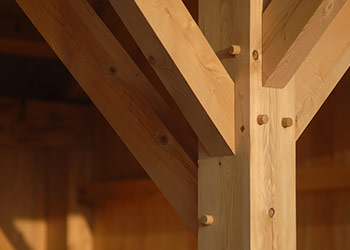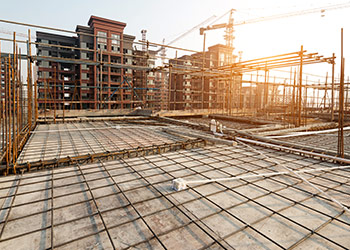-
Fire Safety Design
The fire safety design (or fire strategy) is the means by which fire safety goals are delivered. We work with all stakeholders to agree goals and derive the best solution for projects and clients.
-
Regulatory Approval
Fire safety design, and development of appropriate fire strategies, depends on understanding the basis of design guidance and being able to demonstrate compliance with local regulations.
-
International Codes
Regardless of location, our success relies on our knowledge of the basis of fire safety guidance and our effective communication with approving authorities throughout the design process.
-
Computational Modelling
From well established empirical calculations to the use of 3D computational fluid dynamics (CFD), we can deliver complex computational modelling to overcome financial or design obstacles.
-
Structural Fire Engineering
An important part of any fire strategy is ensuring that structures achieve an adequate standard of fire resistance in the most economical manner. This applies to all forms of construction.
-
Timber Construction
Timber construction is becoming increasingly popular, and fire is often perceived as being a barrier to its use. We are able to use our expertise and experience to enable timber buildings to be built safely.
-
Construction
We can develop fire strategies for phased construction, produce construction fire risk assessments, and attend site to ensure the integrity of the fire safety design is maintained to handover.
-
Operational
We develop our fire safety design with building operation in mind to maximise flexibility and minimise management burden. We also undertake completion and operational fire risk assessments.

-
Fire Safety Design
The fire safety design (or fire strategy) is the means by which legislative and client fire safety goals are delivered in practice.A fire safety design can range from a simple description of how a building complies with recognised design guidance, to a comprehensive solution for specific design challenges that include detailed fire engineering design.
We work closely with clients, design teams, contractors and regulatory authorities to agree all fire safety goals, identify potential risks and offer options to deliver the most appropriate fire safety design for design, construction and operation of buildings.

-
Regulatory Approval
Regardless of the size and complexity of a building, a fire strategy has a crucial part to play in demonstrating compliance with fire safety legislation (e.g. the Building Regulations and Regulatory Reform (Fire Safety) Order) and providing operators with a record of the design.Fire safety design, and the development of an appropriate fire strategy, relies upon understanding the basis of design guidance and the ability to demonstrate that the project complies with local regulations.
We determine the most appropriate design guidance for a project so that it can meet the requirements of those regulations with minimal compromise to the project.
If a project does not easily meet the guidance, we draw on technical expertise in conjunction with a wide range of research outlets, to provide pragmatic fire engineering solutions.

-
International Codes
On international projects, design guidance depends on the project location. We have expertise in the us of international design guidance such as the National Fire Protection Association (NFPA) and International Building Code (IBC), in conjunction with supplementary local requirements.Regardless of the project’s location, our success in obtaining regulatory approval relies on our ability to communicate with approving authorities throughout the design process, which helps to simplify more technical aspects of the design.
We have successfully achieved this in regions outside of Europe, including North America, the Middle East and Australasia.

-
Computational Modelling
Modern architectural ambition means it is not always possible or desirable to develop building designs based on prescriptive design guidance alone. We can provide performance-based engineering calculations to tailor fire safety solutions to buildings, which offers significant benefits to the design.From adoption of well established empirical calculations to use of complex 3D computational fluid dynamics (CFD) simulations, we have significant expertise in providing fire & smoke modelling, thermal radiation analysis and evacuation simulation to demonstrate an appropriate level of safety is provided within the design. This type of computational modelling can ensure that fire strategies overcome financial or design obstacles and achieve the desired architectural goals.

-
Structural Fire Engineering
An important part of any fire strategy is ensuring that the structure achieves an adequate standard of fire resistance. This applies to all forms of construction (steel, concrete, timber etc.) and requires detailed understanding of fire behaviour, heat transfer and structural response.As with a fire strategy, structural fire engineering can range from simple guidance to complex analysis to determine the amount of fire protection or concrete cover required on an element by element basis to achieved the required structural reliability for fire.
Whatever approach is taken, our objective is always to ensure the required reliability can be achieved in the most cost effective manner. This is done by working closely with structural engineers to optimise frame design for fire limit state and then ensuring that fire protection is applied where it is most required and eliminated where it is not necessary. In most instances, correctly applied structural fire engineering delivers significant cost savings and reductions in material thicknesses.

-
Timber Construction
Timber construction is becoming increasingly popular, and being combustible, fire is often perceived by various stakeholders as being a significant barrier to using timber in practice. At DFC, we recognise that all forms of construction have inherent risks with respect to fire and that our job as engineers is to identify those risks and mitigate them, knowingly. In this way, timber can be used as a construction material safely.There are many forms of timber construction; each with its own risks and solutions. At DFC, we ensure that our designs enable client and architectural goals, safely and knowingly, considering both construction risks and the lifetime operation and maintenance of buildings.

-
Construction
During construction, the principles of the fire safety design need to be maintained to avoid expensive retrospective action. Through a construction monitoring role we can identify design and construction issues to make sure that any potential impact is communicated to the design team and efficiently resolved.Where required, we can produce construction site fire safety risk assessments to outline the measures necessary to ensure life safety and property protection during construction. This is beneficial where temporary conditions are complex, high-risk materials are used, or where a phased construction and occupation is required.
We can produce regular updates to the fire strategy during construction to reflect any ongoing alterations on site. This supports continued consultation with approving authorities and provides a route to an as-built fire strategy report when the project is complete.

-
Operational
In existing and completed buildings, it is crucial that the building is managed appropriately so that the principles of the fire strategy are maintained. In most buildings this can be a simple undertaking by end users, but in more complex buildings it is beneficial for a fire engineer to provide consideration of detailed operational issues.We have comprehensive knowledge of the principles of fire engineering and associated fire strategy measures that are typically incorporated within buildings as part of the fire strategy. Through communication, desktop study and site inspection, we can provide fire risk assessments that will ensure buildings are maintained as per the original intent of the fire strategy.
In some instances, existing or heritage buildings do not have a clear and concise fire strategy due to their age or development over long periods. This results in obstructions and challenges for ongoing management and potential refurbishment. Regardless of the age and complexity of a building, we are able to assess existing buildings and provide retrospective fire strategies that give clarity for building management and identify potentially beneficial opportunities for refurbishment works.
